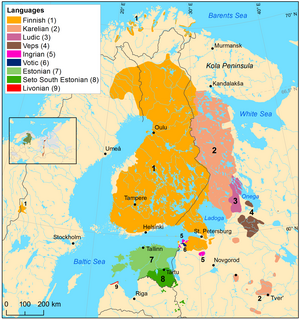 Global Information
Global InformationFinnic languages information
| Finnic | |
|---|---|
| Baltic Finnic, Balto-Finnic | |
| Ethnicity | Balto-Finnic peoples |
| Geographic distribution | Fennoscandia, Estonia, Latvia, Northwestern Russia |
| Linguistic classification | Uralic
|
| Proto-language | Proto-Finnic |
| Subdivisions |
|
| Glottolog | finn1317 |
 Distribution of the Finnic languages at the beginning of the 20th century[1][2] | |
The Finnic or Baltic Finnic languages[a][4] constitute a branch of the Uralic language family spoken around the Baltic Sea by the Baltic Finnic peoples. There are around 7 million speakers, who live mainly in Finland and Estonia.
Traditionally, eight Finnic languages have been recognized.[5] The major modern representatives of the family are Finnish and Estonian, the official languages of their respective nation states.[6] The other Finnic languages in the Baltic Sea region are Ingrian and Votic, spoken in Ingria by the Gulf of Finland, and Livonian, once spoken around the Gulf of Riga. Spoken farther northeast are Karelian, Ludic, and Veps, in the region of Lakes Onega and Ladoga.
In addition, since the 1990s, several Finnic-speaking minority groups have emerged to seek recognition for their languages as distinct from the ones they have been considered dialects of in the past. Some of these groups have established their own orthographies and standardised languages.[5] Võro and Seto, which are spoken in southeastern Estonia and in some parts of Russia, are considered dialects of Estonian by some linguists,[7] while other linguists consider them separate languages. Meänkieli and Kven are spoken in northern Sweden and Norway respectively and have the legal status of independent minority languages separate from Finnish. They were earlier considered dialects of Finnish and are mutually intelligible with it.[8] Additionally, the Karelian language was not officially recognised as its own language in Finland until 2009, despite there being no linguistic confusion about its status.
The smaller languages are endangered. The last native speaker of Livonian died in 2013, and only about a dozen native speakers of Votic remain. Regardless, even for these languages, the shaping of a standard language and education in it continues.[9]
The geographic centre of the maximum divergence between the languages is located east of the Gulf of Finland around Saint Petersburg. A glottochronological study estimates the age of the common ancestor of existing languages to a little more than 1000 years.[10] However, Mikko Heikkilä dates the beginning of the diversification (with South Estonian as the first split) rather precisely to about 150 AD, based on loanword evidence (and previous estimates tend to be even older, like Pekka Sammallahti's of 1000–600 BC). There is now wide agreement that Proto-Finnic was probably spoken at the coasts of the Gulf of Finland.[11]
- ^ Rantanen, Timo; Tolvanen, Harri; Roose, Meeli; Ylikoski, Jussi; Vesakoski, Outi (8 June 2022). "Best practices for spatial language data harmonization, sharing and map creation—A case study of Uralic". PLOS ONE. 17 (6): e0269648. Bibcode:2022PLoSO..1769648R. doi:10.1371/journal.pone.0269648. PMC 9176854. PMID 35675367.
- ^ Rantanen, Timo, Vesakoski, Outi, Ylikoski, Jussi, & Tolvanen, Harri. (2021). Geographical database of the Uralic languages (v1.0) [Data set]. Zenodo. https://doi.org/10.5281/zenodo.4784188
- ^ Ruhlen, Merritt (1991). "Uralic-Yukaghir". A Guide to the World's Languages: Classification. Stanford University Press. p. 69. ISBN 0-8047-1894-6. Archived from the original on 19 April 2023. Retrieved 13 December 2015.
- ^ Abondolo, Daniel Mario; Valijärvi, Riitta-Liisa, eds. (2023). The Uralic languages. Routledge language family (2nd ed.). London New York: Routledge. p. 91. ISBN 978-1-138-65084-8.
- ^ a b Junttila, Santeri (2010). "Itämerensuomen seuraava etymologinen sanakirja" (PDF). In Saarinen, Sirkka; Siitonen, Kirsti; Vaittinen, Tanja (eds.). Sanoista Kirjakieliin. Juhlakirja Kaisa Häkkiselle 17. Marraskuuta 2010. Suomalais-Ugrilaisen Seuran Toimituksia. Vol. 259. ISSN 0355-0230. Archived (PDF) from the original on 4 March 2016. Retrieved 17 October 2015.
- ^ Finnic Peoples Archived 7 September 2008 at the Wayback Machine at Encyclopædia Britannica
- ^ Abondolo, Daniel, ed. (1998). The Uralic Languages. Routledge Language Family Descriptions. Taylor & Francis.
- ^ "Meänkieli, yksi Ruotsin vähemmistökielistä – Kielikello". www.kielikello.fi (in Finnish). Retrieved 10 December 2019.
- ^ Pajusalu, Karl (2009). "The reforming of the Southern Finnic language area" (PDF). Mémoires de la Société Finno-Ougrienne. 258: 95–107. ISSN 0355-0230. Archived (PDF) from the original on 24 September 2015. Retrieved 3 March 2015.
- ^ Jazyk. "Uralic migrations" (PDF). www.phil.muni.cz. Archived from the original (PDF) on 13 May 2019.
- ^ Kallio, Petri (2014). "The Diversification of Proto-Finnic". In Ahola, Joonas; Frog (eds.). Fibula, Fabula, Fact: The Viking Age in Finland (Studia Fennica Historica 18). Helsinki, Finland: Finno-Ugric Society. p. 163f. Archived from the original on 3 June 2022. Retrieved 27 December 2019.
Cite error: There are <ref group=lower-alpha> tags or {{efn}} templates on this page, but the references will not show without a {{reflist|group=lower-alpha}} template or {{notelist}} template (see the help page).